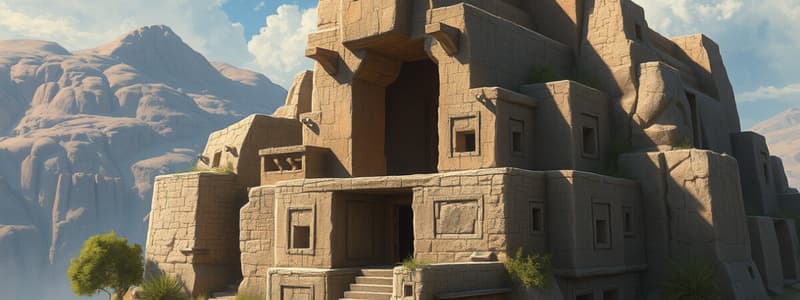Podcast
Questions and Answers
What does the term 'sonder' mean?
What does the term 'sonder' mean?
The realization that each random passerby is living life as vivid and complex as your own.
Which of the following are influences of architecture? (Select all that apply)
Which of the following are influences of architecture? (Select all that apply)
- Geographical Influence (correct)
- Technological Influence
- Historical Influence (correct)
- Climatic Influence (correct)
What is one reason men sought shelter in prehistoric times?
What is one reason men sought shelter in prehistoric times?
Protection from wildlife and natural elements.
What are the three phases of the Stone Age?
What are the three phases of the Stone Age?
The Bronze Age is characterized by the discovery of iron.
The Bronze Age is characterized by the discovery of iron.
What architectural technique was significant in the Iron Age?
What architectural technique was significant in the Iron Age?
Which of the following are classified as religious structures? (Select all that apply)
Which of the following are classified as religious structures? (Select all that apply)
What is a dolmen?
What is a dolmen?
Flashcards are hidden until you start studying
Study Notes
Pre-Historic Architecture Overview
- The concept of "sonder" highlights the complexity of individual lives, connecting to architecture's reflection of time and places while aiming for timelessness (Frank Gehry).
Influences on Architecture
- Geographical Influence: Location affects design; proximity to sea, mountains, and landforms influences architectural styles.
- Geological Influence: Availability of local materials, such as stone, brick, and wood, impacts construction methods and styles.
- Climatic Influence: Weather patterns dictate architectural form, materials, and spatial organization in local architecture.
- Religious Influence: Local beliefs and traditions shape the emotional and spiritual aspects of architectural design.
- Socio-Political Influence: Architecture is used to convey power, ideology, and cultural identity by governments and ruling classes, reflecting local lifestyles.
- Historical Influence: Significant historical events shaped architectural styles by introducing new design principles and materials.
Sumerians and Cultural Exchange
- Sumerians influenced conquered cultures through language, religion, culture, and architecture, while also learning from local practices.
Basic Needs for Shelter
- Humans sought shelter for protection from wildlife, comfort for rest, storage of possessions, and the perpetuation of life.
Ages in Pre-Historic Architecture
-
Stone Age: Divided into three phases:
- Paleolithic Period: Characterized by cave dwelling (Old Stone Age; approx. 2.5 million years ago to 10,000 BCE).
- Mesolithic Period: Transition to detached, free-standing structures (Middle Stone Age; approx. 10,000 BCE to 5,000 BCE).
- Neolithic Period: Construction of huts using stone and mud, burial rituals, and burial mounds (New Stone Age; approx. 5,000 BCE to 2,000 BCE).
-
Bronze Age: Known for advancements in tool-making with bronze, leading to improved construction techniques; notable structure: Treasury of Atreus (Tomb of Agamemnon).
-
Iron Age: Discovery of malleable metals revolutionized tools, enhancing construction efficiency and introducing new building techniques.
Major Construction Principles
- Post and Lintel: Classic structural element where horizontal beams are supported by vertical posts.
- Arch and Vault: Curved structures that revolutionized the spanning of spaces effectively.
- Trussed Construction: Triangular framing providing strength and support.
- Corbel and Cantilever: Techniques creating overhanging structures without external bracing.
Classifications of Structures
-
Religious Structures: Buildings for worship and rituals.
- Monoliths: Large single stone structures or monuments.
- Menhir: Upright stone monuments, often aligned or standalone, serving commemorative purposes.
- Megalithic Architecture: Large stone constructions, celebrating sacred aspects.
- Dolmen: Structures consisting of upright stones supporting a horizontal slab.
- Cromlech: Circular arrangements of stones, enclosing burial sites.
- Stone Circles: Concentric rings often structured around an altar.
- Tumulus: Earth mounds for multiple burials, precursor to pyramids.
-
Dwellings: Structures designed for human habitation, providing shelter and safety.
- Types of Caverns: Include natural caves, artificial caves, and above-ground structures.
-
Example: Tabon Cave in Palawan, significant archaeological site illustrating early human habitation.
Studying That Suits You
Use AI to generate personalized quizzes and flashcards to suit your learning preferences.




